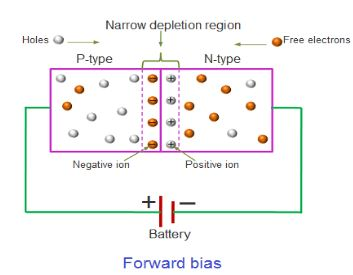
When a forward bias is applied to a p-n junction, it.
Answer
465.9k+ views
Hint: A p-n junction diode device is made when a p-type semiconductor is fused to an n-type semiconductor forming a potential barrier voltage across the diode junction. Generally, it’s a semiconductor device that controls the flow of current in a circuit. In the forward bias condition, a negative voltage is applied on the N-side and is connected with a negative voltage, and P-side is connected with a positive voltage.
Complete answer:
In the p-n junction diode, a depletion region is made due to the recombination of holes and electrons. Electrons from the n side move towards the p side, and holes from the p side move towards the n side to make the depletion region. As a result, an electric field in the opposite direction is formed whenever the external voltage is applied; this is often nothing but barrier potential.

In forward biasing, the p-type is connected with the positive terminal and thus the n-type is connected with the negative terminal of the battery then, the holes in the p-type region and therefore the electrons within the n-type region are pushed towards the junction which reduces the width of the depletion layer. Also the distance between the diffused holes and electrons decreases which ends up in a decrease in field within the depletion region. Hence, the potential barrier decreases.
Note: The width of the depletion layer in a p-n junction diode decreases in forward bias because of the repulsion of carriers from battery terminals, holes from p-type, and electrons from n-type. Now, due to the small number of ions within the depletion region, its potential decreases.
Complete answer:
In the p-n junction diode, a depletion region is made due to the recombination of holes and electrons. Electrons from the n side move towards the p side, and holes from the p side move towards the n side to make the depletion region. As a result, an electric field in the opposite direction is formed whenever the external voltage is applied; this is often nothing but barrier potential.

In forward biasing, the p-type is connected with the positive terminal and thus the n-type is connected with the negative terminal of the battery then, the holes in the p-type region and therefore the electrons within the n-type region are pushed towards the junction which reduces the width of the depletion layer. Also the distance between the diffused holes and electrons decreases which ends up in a decrease in field within the depletion region. Hence, the potential barrier decreases.
Note: The width of the depletion layer in a p-n junction diode decreases in forward bias because of the repulsion of carriers from battery terminals, holes from p-type, and electrons from n-type. Now, due to the small number of ions within the depletion region, its potential decreases.
Recently Updated Pages
State the De Morgans Law class 12 physics CBSE

What is the ecosystem Discuss its different components class 12 biology CBSE

Two point electric charges of values q and 2q are kept class 12 physics CBSE

A Bio convex lens of Focal length 15 cm is in Front class 12 physics CBSE

The geometry of a methyl carbanion is likely to be class 12 chemistry CBSE

What is the probability that a leap year has 53 Su-class-12-maths-CBSE

Trending doubts
What are the major means of transport Explain each class 12 social science CBSE

Which are the Top 10 Largest Countries of the World?

Draw a labelled sketch of the human eye class 12 physics CBSE

Explain sex determination in humans with line diag class 12 biology CBSE

The pH of the pancreatic juice is A 64 B 86 C 120 D class 12 biology CBSE

Explain sex determination in humans with the help of class 12 biology CBSE




